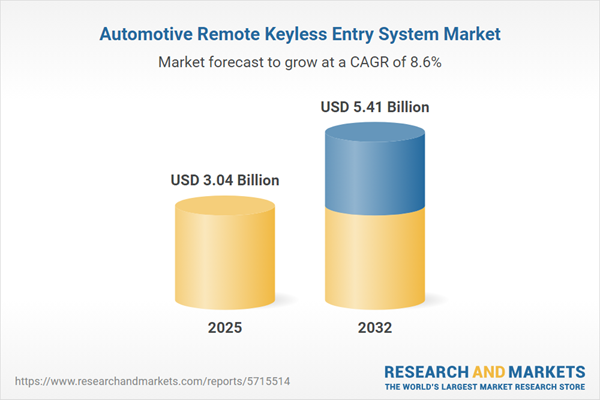Speak directly to the analyst to clarify any post sales queries you may have.
Senior decision-makers across the automotive industry are prioritizing robust vehicle access solutions, prompted by the need for higher operational agility and security during rapid technological transformation. Digital keyless systems are emerging as foundational tools within connected vehicle strategies, supporting modernization efforts and compliance objectives.
Market Snapshot: Automotive Remote Keyless Entry System Market
The automotive remote keyless entry system market is undergoing strong, sustained growth as more organizations integrate digital access technologies across both commercial and passenger vehicles. OEMs and fleet operators are driving adoption of keyless entry, focusing on advanced system integration and Cybersecurity to maintain secure, scalable mobility. These priorities align with the demand for resilient operations and efficient communication within increasingly interconnected automotive environments. As a result, sector participants continue investing in flexible access technologies, which help companies address evolving regulatory requirements and digital innovation across global and regional markets.
Scope & Segmentation
- System Types: Keyless Go, remote keyless entry, and smart key solutions support both retrofits and new model installations. This breadth offers manufacturers and aftermarket providers flexible options to implement or upgrade access control across vehicle lifecycles.
- Vehicle Types: Solutions are configured for passenger vehicles, light commercial fleets, and heavy-duty transport. This enables private users and large enterprise operators to tailor mobility and management approaches for distinct operational environments.
- Technology Protocols: Bluetooth, Wi-Fi, NFC, and RFID technologies are leveraged to deliver fast, adaptable access at scale. These technologies enable reliable connectivity for individual users and entire fleets, emphasizing both convenience and security.
- Components: Integrated antennas, advanced sensors, transmitters, receivers, specialized circuits, and modules—both infrared and RF—ensure secure entry and consistent system performance despite varying operating challenges.
- Distribution Channels: OEM direct installation and a strong aftermarket network offer organizations flexibility in deploying and maintaining access systems, enabling ongoing compliance and system upgrades throughout the vehicle’s service life.
- Frequency Bands: Use of frequency ranges from low to ultra-high reduces interference and allows stable system operation in modern automotive environments.
- Regions: The Americas, Europe, Middle East & Africa, and Asia-Pacific markets each have distinct infrastructure, regulatory, and customer preference landscapes shaping adoption strategies and investment levels.
- Localized Markets: Country-specific adaptations are informed by supply chain factors, local regulation, and operational practices across the United States, Canada, Mexico, Brazil, United Kingdom, Germany, France, China, India, Japan, and Australia.
- Key Companies: Leading industry players such as Robert Bosch GmbH, Continental AG, DENSO Corporation, Valeo SA, Aptiv PLC, Visteon Corporation, AISIN SEIKI Co., Ltd., Hitachi Astemo, Ltd., and Huf Hülsbeck & Fürst GmbH & Co. KG influence technology standards and competitive benchmarks worldwide.
Key Takeaways for Senior Decision Makers
- Multi-frequency and encrypted keyless entry systems provide strong defense, supporting enhanced fleet oversight and reducing exposure to unauthorized access or business interruptions.
- Partnerships between vehicle manufacturers and technology providers result in modular platforms, promoting simplified adoption and efficient management across diverse fleets.
- The integration of biometric authentication and artificial intelligence features enables security policies to adapt dynamically, meeting rising regulatory expectations while enhancing user flexibility.
- Standardization across regions makes fleet management easier for multinational organizations by aligning operational protocols and streamlining compliance efforts.
- Proactive attention to regional adoption patterns—such as Europe’s integrated security focus and Asia-Pacific’s emphasis on rapid digital transition—strengthens investment decisions and capability deployment.
- Aftermarket expansion ensures that vehicle access systems can be upgraded beyond initial delivery, maintaining compliance and supporting digital transformation as business models shift.
Tariff Impact: Supply Chain and Cost Dynamics
Recent adjustments to United States tariffs on imported components including sensors and antennas have prompted industry stakeholders to evaluate and revamp sourcing and production strategies. This shift is driving increased investments in domestic manufacturing and automation to boost supply chain resilience and reduce exposure to external shocks. Flexible product design and adaptive procurement have become essential for maintaining cost control and stable operations, particularly as global trade and policy conditions bring new challenges.
Methodology & Data Sources
This report draws on comprehensive secondary research, targeted executive interviews with leaders at automotive OEMs, and review of both regulatory documentation and patent filings. Detailed scenario modeling and data triangulation ensure that senior audiences receive actionable, accurate insights to guide market strategy and planning.
Why This Report Matters
- Analyzes critical technological progress, compliance pathways, and operational best practices to support secure, efficient fleet management in evolving markets.
- Offers strategic insight into adoption patterns, supplier trends, and regional variations to inform proactive decision-making.
- Helps organizations prepare for potential supply chain or policy disruptions and seize new partnership opportunities as keyless access technologies develop.
Conclusion
Advances in digital vehicle access are empowering automotive organizations to optimize flexibility and resilience. Leading-edge access systems, combined with strong supply networks, will support compliance and efficient fleet management as industry environments evolve.
Additional Product Information:
- Purchase of this report includes 1 year online access with quarterly updates.
- This report can be updated on request. Please contact our Customer Experience team using the Ask a Question widget on our website.
Table of Contents
3. Executive Summary
4. Market Overview
7. Cumulative Impact of Artificial Intelligence 2025
Companies Mentioned
The companies profiled in this Automotive Remote Keyless Entry System market report include:- Robert Bosch GmbH
- Continental AG
- DENSO Corporation
- Valeo SA
- Aptiv PLC
- Visteon Corporation
- AISIN SEIKI Co., Ltd.
- Hitachi Astemo, Ltd.
- Huf Hülsbeck & Fürst GmbH & Co. KG
Table Information
| Report Attribute | Details |
|---|---|
| No. of Pages | 185 |
| Published | October 2025 |
| Forecast Period | 2025 - 2032 |
| Estimated Market Value ( USD | $ 3.04 Billion |
| Forecasted Market Value ( USD | $ 5.41 Billion |
| Compound Annual Growth Rate | 8.5% |
| Regions Covered | Global |
| No. of Companies Mentioned | 10 |









